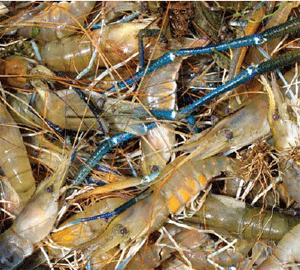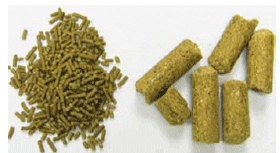
The highly fluctuating and ever-increasing costs of fishmeal
and fish oil ingredients used in aquaculture diets, combined with
concerns regarding their limited availability and sustainability,
have stimulated research efforts throughout the past two decades
to find suitable alternatives. Numerous feedstuffs have been evaluated
as either partial or complete substitutes for both fishmeal and
fish oil.
Often, however, these substitutions
resulted in significantly lower growth
often without sufficient provision of
essential long-chain polyunsaturated fatty
acids (LC-PUFAs), particularly those of
the n-3 linolenic family, such as docosahexaenoic
acid (22:6) and ecisopentaenoic
acid (20:5).
Low-Input Culture
Low-input culture practices for freshwater
prawns, Macrobrachium rosenbergii,
were partially developed over the past 10
years to effectively manage growth and
biological characteristics specific to this
species of crustacean. Its growth rates
decline as the stocking density and corresponding
resident biomass in production
ponds increase. In addition, males in the
farmed populations are polymorphic, and
the proportional presence of the slowest-growing
and undesirable small morphs
increases as stocking density increases.
Investigations of low-input culture ultimately resulted in conditions
that optimized commercial net returns. Stocking at low
densities of 24,700 to 29,640/ha reduces the costs of stocking and
feed required during the growing season.
Additionally, due to the inverse relationship between stocking
density and mean harvest weight, larger harvested prawns
command higher prices, thereby optimizing the net return. The
low-input culture strategy also makes available a higher proportional
contribution of natural productivity as food for each
prawn to help satisfy nutrient requirements for growth.
Range Cubes

The substantial pond-derived nutrients allow for the successful
use of range cubes, a commercially available livestock feed
supplement, as part of the low-input production strategy. The
range cubes have a protein content derived from plant feedstuffs
that ranges from 20 to 22%, and contain no fishmeal or fish oil.
Fatty acid analysis revealed no detectable LC-PUFA in the
range cubes fed to the prawns.
However, production achieved with range cubes under lowinput
pond culture conditions has been comparable to that achieved when a commercially available prawn feed containing
fishmeal and fish oil was fed. The prawn feed costs approximately
100% more than range cubes.
Required nutrients, particularly LC-PUFAs, are presumably
derived from the consumption of pond organisms such as insect
larvae. Levels of LC-PUFA are apparently sufficient to satisfy
the essential fatty acid requirements of this species, whose LCPUFA
requirements are approximately 0.08% of the diet, in
comparison to 0.5 to 1.0% for marine shrimp.
However, levels of LC-PUFA in the tail muscles of prawns
fed the range cubes were lower than those found in prawns fed
the nutritionally complete, commercial prawn feed. Therefore,
the question arose as to whether the tissue levels of the LCPUFAs
could be enhanced by a cost-effective strategy using
prawn feed for a short period before harvest.
The idea of improving the nutritional appeal of the shrimp
while saving on the costs of feeding a diet containing fishmeal and/
or fish oil for the entire growing season was subsequently investigated
in two experiments conducted in sequential growing seasons.
Initial Feeding Test
For the first experiment, prawns were stocked at 24,700/ha
in three treatments. The prawns were fed either the range cubes
or the prawn feed exclusively for the entire 18-week growing
season. A third treatment consisted of the feeding of range cubes for the first 12 weeks, followed by a six-week period during
which a nutritionally complete commercial prawn feed containing
LC-PUFAs from menhaden fish oil and fishmeal was fed.
The prawn feed was fed at one-half of the feeding rate of the
range cubes in the interest of reducing costs, while recognizing
the prawn feed was nutritionally complete. At the end of the
growing season, there was no difference in growth or survival
among the three treatments. The qualitative LC-PUFA content
of the tail muscle tissue of prawns harvested from all three treatments
was very similar.
The quantitative LC-PUFA content of prawns fed the commercial
diet for either the entire growing season or the last six
weeks was essentially the same and notably higher than that
found in prawns fed the range cubes exclusively. Expressed as
percent of total fatty acids, the 20:5n-3 and 22:6n-3 levels for
prawns harvested from the pre-harvest feed change group were 6
and 2.5%, respectively, higher than those observed for the
prawns fed only range cubes.
LC-PUFA Enhancement
A second, follow-up experiment was conducted to determine
whether the amount of time necessary to enhance the LC-PUFA
composition by feeding the prawn feed could be reduced to three
or two weeks prior to harvest. Range cubes were again fed exclusively
as one treatment, and prawn feed was fed at half the rate of
the range cubes for the period prior to harvest.
Again, there was no difference in survival or total production
among the treatments, and the relative proportions of the LCPUFA
when feeding the prawn diet for six weeks prior to harvest
were the same as those observed the previous year. However,
for the three-week and two-week pre-harvest feeding treatments,
the LC-PUFA levels were 2.5 and 1.1% less (expressed as
percent of total fatty acids) for 20:5n-3 and 22:6n-3 (Table 1).
This decline for the two- and three-week pre-harvest treatments
could be the result of a lower amount of food consumed,
corresponding to a decline in pond water temperatures as the
growing season came to an end. The periods of time prior to
harvest when pond temperatures were recorded as greater than
27 C at midday were 71.8, 54.2 and 35.3% for the six-week,
three-week and two-week pre-harvest treatments, respectively.
Perspectives
The experiments indicated that culture
of species with comparatively low LCPUFA
requirements can be achieved on
diets with no fishmeal or fish oil and lower
levels of crude protein under low-density
conditions. Since response to the dietary
LC-PUFAs and their corresponding accumulation
in the prawn tissue were very
rapid, the levels of these fatty acids that are
important in human nutrition were effectively
increased in the tail muscle during
the last third of the growing season at a
very low increase in total feed expense. In
fact, for the six-week pre-harvest application
of prawn feed, the cost of the harvested
prawns increased by only U.S.
$0.24/kg.
To meet consumer demand, LCPUFA
levels could be enhanced in freshwater
prawns or other species by providing
a finishing feed of the same
ingredient composition but with a fish oil
or comparatively effective oil of suitable
LC-PUFA content added or sprayed on.
The six-week duration of this pre-harvest
feeding is effective at temperate latitudes
and possibly could be reduced for warmer
water temperatures, when rates of consumption
would be higher.
May 2012


